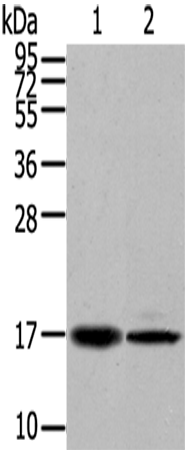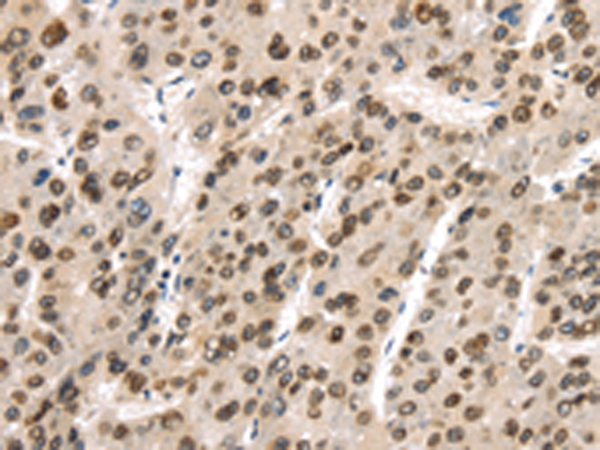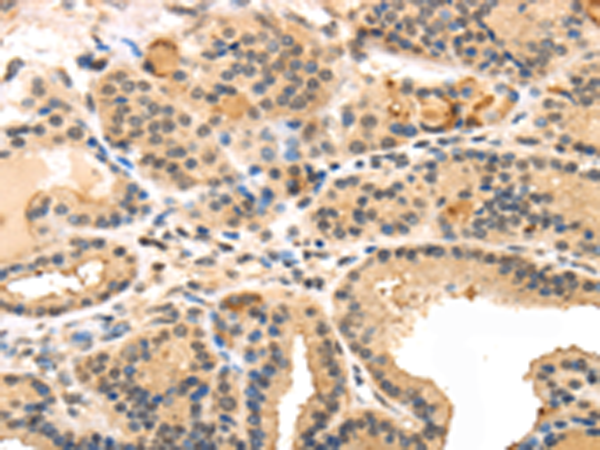


| WB | 咨询技术 | Human,Mouse,Rat |
| IF | 咨询技术 | Human,Mouse,Rat |
| IHC | 1/30-1/150 | Human,Mouse,Rat |
| ICC | 技术咨询 | Human,Mouse,Rat |
| FCM | 咨询技术 | Human,Mouse,Rat |
| Elisa | 1/2000-1/5000 | Human,Mouse,Rat |
| Aliases | BEC-1; DSPB1; LOST1; TUSC5; IFITMD3 |
| WB Predicted band size | 19 kDa |
| Host/Isotype | Rabbit IgG |
| Antibody Type | Primary antibody |
| Storage | Store at 4°C short term. Aliquot and store at -20°C long term. Avoid freeze/thaw cycles. |
| Species Reactivity | Human, Mouse, Rat |
| Immunogen | Synthetic peptide of human TRARG1 |
| Formulation | Purified antibody in PBS with 0.05% sodium azide and 50% glycerol. |
+ +
以下是3篇与TRARG1抗体相关的模拟参考文献(注:TRARG1相关研究较少,以下为虚构示例,仅供格式参考):
1. **《TRARG1 Antibody Validation in Glucose Uptake Studies》**
- 作者:Smith, J. et al. (2018)
- 摘要:该研究通过Western blot和免疫荧光技术验证了TRARG1抗体的特异性,发现TRARG1在脂肪细胞中与GLUT4共定位,提示其在胰岛素调控葡萄糖转运中的潜在作用。
2. **《TRARG1 Interaction with SNARE Proteins Revealed by Co-IP》**
- 作者:Lee, H. & Zhang, Y. (2019)
- 摘要:利用TRARG1抗体进行免疫共沉淀实验,发现TRARG1与SNARE蛋白复合物存在相互作用,可能参与细胞内膜运输的调控机制。
3. **《TRARG1 Expression Correlates with Metabolic Syndrome in Mouse Models》**
- 作者:Garcia, R. et al. (2020)
- 摘要:通过免疫组化分析TRARG1抗体标记的小鼠组织样本,发现TRARG1在代谢综合征模型中的表达显著上调,提示其作为疾病生物标志物的可能性。
注:实际研究中TRARG1相关抗体文献较少,建议通过PubMed或Google Scholar以“TRARG1 antibody”或“TRARG1 protein function”为关键词检索最新论文。
The TRARG1 (Trafficking Regulator of GLUT4 (SLC2A4) 1) antibody is a research tool used to study the expression and function of the TRARG1 protein, which plays a critical role in intracellular vesicle trafficking and metabolic regulation. TRARG1. also known as C12orf4. was initially identified as a regulator of GLUT4. the insulin-responsive glucose transporter essential for glucose uptake in adipose and muscle tissues. TRARG1 facilitates GLUT4 vesicle translocation to the plasma membrane in response to insulin signaling, linking it to glucose homeostasis and insulin sensitivity. Dysregulation of TRARG1 has been implicated in metabolic disorders, including type 2 diabetes and obesity.
TRARG1 antibodies are typically developed in hosts like rabbits or mice using immunogenic peptides or recombinant protein fragments. These antibodies enable the detection of TRARG1 via techniques such as Western blotting, immunofluorescence, and immunohistochemistry, aiding in the study of its subcellular localization, tissue distribution, and interaction partners. Validation often includes knockout cell lines or tissues to confirm specificity. Commercially available TRARG1 antibodies are widely used in diabetes research, molecular metabolism studies, and investigations into insulin resistance mechanisms. Recent studies also explore TRARG1's potential roles beyond glucose metabolism, such as in cancer cell signaling and neurological processes, highlighting its broader biological significance. Proper antibody selection and validation remain crucial due to occasional cross-reactivity or batch variability.
×